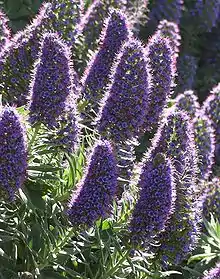Echium candicans
Echium candicans, the pride of Madeira, is a species of flowering plant in the family Boraginaceae, native to the island of Madeira. It is a large herbaceous perennial subshrub, growing to 1.5–2.5 m (4 ft 11 in–8 ft 2 in).[3]
| Pride of Madeira | |
|---|---|
 | |
| Scientific classification | |
| Kingdom: | Plantae |
| Clade: | Tracheophytes |
| Clade: | Angiosperms |
| Clade: | Eudicots |
| Clade: | Asterids |
| Order: | Boraginales |
| Family: | Boraginaceae |
| Genus: | Echium |
| Species: | E. candicans |
| Binomial name | |
| Echium candicans | |
| Synonyms[2] | |
| |
In the first year after germination the plant produces a broad rosette of leaves. In the second and subsequent years more or less woody flowering stalks are produced clothed in rough leaves. The flower head is large and covered with white or blue flowers having red stamens. It is much visited by bees and butterflies for its nectar.[4]
Etymology
The Latin specific epithet candicans means “shining white”, referring to one colour form of this species.[5]
Cultivation
Echium candicans is cultivated in the horticulture trade and widely available throughout the world as an ornamental plant for traditional and drought tolerant water conserving gardens. It is particularly suitable for coastal planting. With a minimum temperature requirement of 5–7 °C (41–45 °F), in frost-prone areas it needs some winter protection. It has gained the Royal Horticultural Society's Award of Garden Merit.[6][7]
Invasive species
In California, it is an invasive species. It is removed from native plant communities as part of habitat restoration efforts in coastal parks such as the Golden Gate National Recreation Area.[8]
In New Zealand it is a common garden escapee onto road-side verges and shingle banks throughout the drier parts of both the North and the South Islands.
In the state of Victoria, Australia, it is considered to be a high weed risk and an alert has been posted by the Department of Primary Industries.[9]
References
- Carvalho, J.A. (2011). "Echium candicans". IUCN Red List of Threatened Species. 2011: e.T162036A115869493. doi:10.2305/IUCN.UK.2011-1.RLTS.T162036A5538047.en.{{cite iucn}}: error: |doi= / |page= mismatch (help)
- The Plant List: A Working List of All Plant Species, retrieved 6 November 2015
- RHS A-Z encyclopedia of garden plants. United Kingdom: Dorling Kindersley. 2008. p. 1136. ISBN 978-1405332965.
- "Echium candicans". Germplasm Resources Information Network (GRIN). Agricultural Research Service (ARS), United States Department of Agriculture (USDA).
- Harrison, Lorraine (2012). RHS Latin for Gardeners. United Kingdom: Mitchell Beazley. ISBN 978-1845337315.
- "RHS Plant Selector - Echium candicans". Retrieved 23 February 2020.
- "AGM Plants - Ornamental" (PDF). Royal Horticultural Society. July 2017. p. 35. Retrieved 6 February 2018.
- "Echium candicans Profile". California Invasive Plant Council. 2017-03-20. Retrieved 8 December 2019.
- "Pride of Madeira – Echium candicans". Retrieved 20 June 2012.

| Wikimedia Commons has media related to Echium candicans. |
